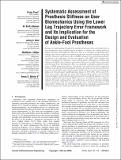Systematic Assessment of Prosthesis Stiffness on User Biomechanics Using the Lower Leg Trajectory Error Framework and Its Implication for the Design and Evaluation of Ankle-Foot Prostheses
Author(s)
Prost, Victor; Johnson, W Brett; Kent, Jenny A; Major, Matthew J; Winter, Amos G
DownloadPublished version (4.792Mb)
Publisher Policy
Publisher Policy
Article is made available in accordance with the publisher's policy and may be subject to US copyright law. Please refer to the publisher's site for terms of use.
Terms of use
Metadata
Show full item recordAbstract
Advances in understanding the effects the mechanical characteristics of prosthetic feet on user biomechanics have enabled passive prostheses to improve the walking pattern of people with lower limb amputation. However, there is no consensus on the design methodology and criteria required to maximize specific user outcomes and fully restore their mobility. The Lower Leg Trajectory Error (LLTE) framework is a novel design methodology based on the replication of lower leg dynamics. The LLTE value evaluates how closely a prosthetic foot replicates a target walking pattern. Designing a prosthesis that minimizes the LLTE value, optimizes its mechanical function to enable users to best replicate the target lower leg trajectory. Here, we conducted a systematic sensitivity investigation of LLTE-optimized prostheses. Five people with unilateral transtibial amputation walked overground at self-selected speeds using five prototype energy storage and return feet with varying LLTE values. The prototypes' LLTE values were varied by changing the stiffness of the participant's LLTE-optimized design by 60%, 80%, 120%, and 167%. Users most closely replicated the target able-bodied walking pattern with the LLTE-optimized stiffness, experimentally demonstrating that the predicted optimum was a true optimum. Additionally, the predicted LLTE values were correlated to the user's ability to replicate the target walking pattern, user preferences, and clinical outcomes including roll-over geometries, trunk sway, prosthetic energy return, and peak push-off power. This study further validates the use of the LLTE framework as a predictive and quantitative tool for designing and evaluating prosthetic feet.
Date issued
2023-04-01Department
Massachusetts Institute of Technology. Department of Mechanical EngineeringJournal
Journal of Biomechanical Engineering
Publisher
ASME International
Citation
Prost, Victor, Johnson, W Brett, Kent, Jenny A, Major, Matthew J and Winter, Amos G. 2023. "Systematic Assessment of Prosthesis Stiffness on User Biomechanics Using the Lower Leg Trajectory Error Framework and Its Implication for the Design and Evaluation of Ankle-Foot Prostheses." Journal of Biomechanical Engineering, 145 (4).
Version: Final published version